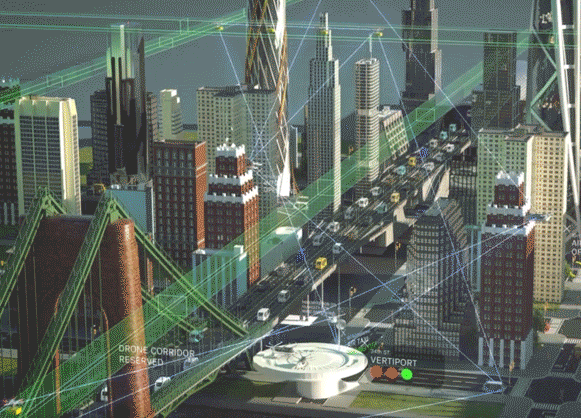
DRF designs technology to help autonomous airborne activities safely meet their full potential for society’s benefit. Its intent is to form a connected, interwoven “fabric” of intelligence that sends aircraft specific, tailored information, wherever they are, says a NASA press release.
Reducing airspace congestion to increase safety in cities while connecting people and services are the kinds of considerations driving the DRF team. And so, in February and March, the team is performing the first test of its technology in a simulated urban area, one modeled on the Phoenix metropolitan area.
Data and Decision-Making
In early February, NASA, along with its partners, began field trials for the current prototype system. This partnership group included Autonomy Association International of Mountain View, California, as well as members from academia, industry, government, communities, tribal nations, and more than 22 cities across Arizona’s Maricopa, Pinal, Pima, and Yuma Counties.
“This activity can help providers of data and decision-support services better understand the needs of future airspace users and the benefits of DRF,” said Kenneth Freeman, DRF’s principal investigator at NASA’s Ames Research Center in California’s Silicon Valley. “Users are able to compare multiple services to select the one that fits their needs: weather data from this source, air traffic updates from another. With further development, we expect this model to potentially drive innovation in the industry, which could lead to improvements in the quality of airspace services.”
The Phoenix test looks at specific scenarios where DRF could be useful, studying them in the context of a simulated drone flight to deliver medical equipment and supplies from downtown Phoenix to the outermost areas of the greater region.
Future scenarios might involve insulin delivery for people in locations with limited access to health care services or re-routing an air taxi around a sudden dust storm.
The test participants are working within the digital ecosystem enabled by DRF, assessing their ability to select data and reasoning services that support safe and autonomous flight.
DRF’s potential to accelerate airborne emergency response was illustrated in a previous test with the California wing of the Civil Air Patrol. Using simulated drone flights, the DRF technology helped locate lightning-induced wildfires more quickly than usual.
Agile Responses to Anomalies
When something unexpected occurs in a flight path, such as a storm, the announcement of a no-fly zone, or a drop in communication coverage, safety depends on the ability to make critical choices at a moment’s notice.
DRF’s current field test studies how well its system can support rerouting an aircraft due to several different anomalies: communication disruptions – for instance, between the aircraft and weather sensors, navigation aids, or ground control – an unidentified or unexpected drone in the flight path, and sudden changes in local weather conditions.
In such scenarios, DRF technology is designed to alert an aircraft approaching one of these anomalies and connect them to services that can provide more information and guidance to respond with agility.
To accomplish its goals, DRF uses edge computing, a system where data is handled, processed, and stored locally – at the “edge” of the network – rather than being sent to a cloud or a data center. This reduces the delays associated with transmitting large sets of data and allows for faster decision-making in time-sensitive situations.
A Future of Advanced Air Mobility
Across NASA, researchers are conducting Advanced Air Mobility studies that will transform U.S. communities, creating new ways to move people and goods in the sky. The data and AI-based decision-support tools enabled by the DRF concept will help further the AAM community’s goals by providing information needed for future flight operations.
This air transportation system of the future will include low-altitude passenger travel options, cargo delivery, and public service capabilities. NASA is delivering data that guides industry’s development of electric air taxis and drones and assists the Federal Aviation Administration’s safe integration of such vehicles into the national airspace.
Today, the DRF team is looking ahead for needs that can be addressed with autonomous flights supported by their digital ecosystem, helping enable the future of air mobility.
DRF is an exploratory activity under the Convergent Aeronautics Solutions project, which is designed to give NASA researchers the resources and pathways they need to determine whether their ideas to solve some of aviation’s biggest technical challenges are feasible and potentially worthy of additional pursuit within NASA or by industry.
Service providers, academics, and end users interested in partnering with DRF can visit the project’s website to learn more and connect with the team.
The DRF technology helps assemble diverse sets of data from various providers, as well as reasoning services powered by artificial intelligence, to make sense of the complex and dynamic airspace.
A familiar reasoning service is the navigation app many people have on their phone. Different kinds of data – maps, accident reports, traffic conditions – are drawn in by the app, which sorts through it all and tells the driver the best route to take at the time.
Decisions needed by autonomous aircraft of the future could be made in a similar way. And the web, or “fabric,” of intelligence enabled by DRF will provide critical information to operators and autonomous aircraft, wherever they are, to make decisions in time.
For more information visit:
www.nasa.gov

